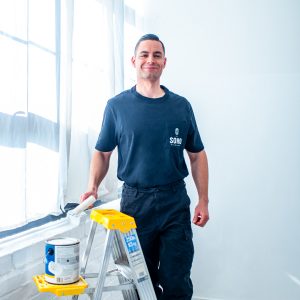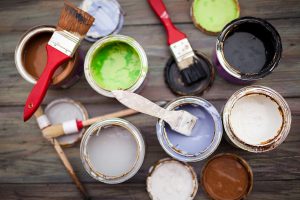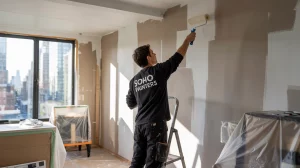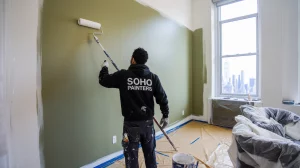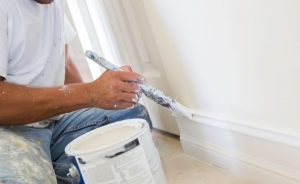If it’s your first DIY project that involves painting drywall, you’re probably wondering if you can paint it without mudding.
The short answer? It’s not recommended. The general rule of thumb is to properly tape and mud drywall joints before painting. Not only will skipping this step lead to unattractive walls, but it is also against building codes.
So yes, mudding the drywall before applying the first coat of paint is a necessary step.
Why Drywall Mud is Important
Drywall mud is used to cover the seams where the pieces of drywall meet. It helps protect the wiring, plumbing, and structural support in your wall from moisture and prevent invasion of pests.
Drywall is made of fire-resistant gypsum material, and a taped and sealed drywall can slow or stop fires. On the other hand, if the drywall is not sealed properly, it won’t be able to function as a fire-suppressant. This is the main reason it is against the building code in many areas to have an unfinished drywall.
How to Properly Mud and Paint Drywall
Trust us, making the effort to properly finish your drywall with mud and tape before you paint it is totally worth it. The end result will be an attractive, easy to maintain, and safe structure.
In this section, we’ll teach you how to get it done right to achieve a smooth finish.
1. Seal drywall seams.
The very first step is to seal the seams of your drywall using drywall tape and mud, which is also called joint compound. While many would recommend using paper tape for a smoother finish, it can be much easier for someone who is inexperienced to use mesh drywall tape instead.
There are many types of mesh tapes that are adhesive, which means they can be stuck in place on their own, and therefore easier to use compared to using joint compound to keep the paper tape in place.
Using a putty knife, spread a moderate coat of mud over the tape. One of the most common mistakes of novice DIYers is that they try to do too much at once when finishing drywall. Keep in mind that you don’t need to accomplish the mudding task in a single coat.
Begin by covering the tape placed on the seams between drywall sheets and from there, build up to a smooth finish.
2. Apply multiple coats of drywall mud.
If you want a smooth finish, about 2 to 3 coats of drywall mud are enough. However, according to an article on SFGate, if you’re finishing an irregular wall, you might need a fourth or even a fifth coat.
When applying coats of mud, you need to do it in 24-hour intervals to give it enough time to dry. Before applying a new coat. Sand the drywall joints with 120 or 150 grit sandpaper to smooth out rough areas. Just be careful not to sand too much to the point that the edges of the tape are already visible.
You might also want to use a specialized topping mud for your final coat. After applying the final coat, sand the joints for the last time, starting with the 120 grit sandpaper for rough areas and ridges, 150 grit sandpaper to smoothen the joints and blend the mud properly, and then a 220 grit sandpaper for a perfectly smooth finish.
3. Prime your drywall.
Before painting your drywall, you need to apply a primer to prevent peeling. This also hides the color variations between your drywall seams and paper, and provides a blank canvas for your paint to bond.
Without priming the wall, you will need several coats of paint to cover the drywall with your chosen color.
4. Paint your wall.
After all the preparation has been completed, it’s time to paint your sealed and primed drywall. Regardless of the type of paint you choose, it will stick better to a properly sealed and primed drywall than in plain drywall paper.
Some beginners choose a matte finish or flat paint, as drywall seams get more visible in high-gloss paint. It is never a good idea to directly paint your drywall with the final paint color of your choice. You will just end up using more coats of paint to properly cover the surface. Also, paint sometimes doesn’t adhere well to the outermost layer of drywall.
Overtime, latex, oil-based, and alkaline paints will peel off your drywall when you apply them directly.
The Most Trusted Painting Contractor in New York
DIY home improvement projects can be exhausting, time-consuming, and costly. If you want to go the easy route, simply hire a local contractor to do the heavy lifting for you.
Soho Painters is the most trusted painting company in New York for commercial and residential painting. We also offer a wide range of services including drywall installation, interior painting, wallpapering, custom murals, venetian plaster, and power washing.
So get in touch with us today and let us discuss how we can help you in your project!

